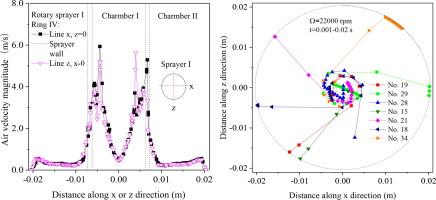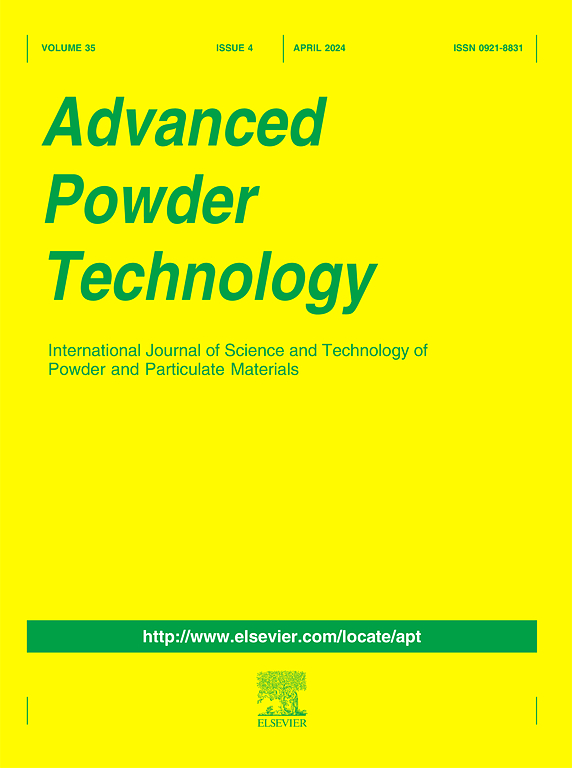Simulations of hydrodynamics of droplet coating process using airless rotary sprayers
IF 4.2
2区 工程技术
Q2 ENGINEERING, CHEMICAL
引用次数: 0
Abstract
Hydrodynamics of droplet coating process are simulated using an airless rotary sprayer by means of CFD-discrete element method (DEM) with JKR contact model. The surface energy parameter used in the JKR model is calibrated by a virtual accumulation angle test. A reasonable wall-droplet surface energy is suggested according to accumulation angle distribution. The droplet translational and angular velocities are predicted at different rotation speeds of the rotary sprayer labeled I, II and III. For stationary rotary sprayer coating process, the droplet translational and angular velocities, normal and tangential forces and energy losses are proportional to rotation speeds. As the rotary sprayer moves forward, the droplet-wall collision normal and tangential forces and energy losses are large near the inlet region and trends constantly in the developed region. This work suggests that DEM could be a useful method to study the effect of rotation speeds on droplet-wall contact interactions in paint droplet coating process.

使用无气旋转喷雾器对液滴喷涂过程进行流体力学模拟
通过 CFD-离散元法(DEM)和 JKR 接触模型,使用无气旋转喷雾器模拟了液滴喷涂过程的流体力学。通过虚拟积聚角测试校准了 JKR 模型中使用的表面能参数。根据积聚角分布,提出了合理的壁面-液滴表面能。预测了旋转喷雾器在不同转速下的液滴平移速度和角速度,分别标为 I、II 和 III。对于静止的旋转喷雾器喷涂过程,液滴的平移速度和角速度、法向力和切向力以及能量损失与旋转速度成正比。随着旋转喷涂机的前进,液滴与液滴壁碰撞的法向力和切向力以及能量损失在入口区附近较大,而在发达区则呈不断增大的趋势。这项工作表明,DEM 可以作为一种有用的方法来研究涂料液滴喷涂过程中旋转速度对液滴壁接触相互作用的影响。
本文章由计算机程序翻译,如有差异,请以英文原文为准。
求助全文
约1分钟内获得全文
求助全文
来源期刊

Advanced Powder Technology
工程技术-工程:化工
CiteScore
9.50
自引率
7.70%
发文量
424
审稿时长
55 days
期刊介绍:
The aim of Advanced Powder Technology is to meet the demand for an international journal that integrates all aspects of science and technology research on powder and particulate materials. The journal fulfills this purpose by publishing original research papers, rapid communications, reviews, and translated articles by prominent researchers worldwide.
The editorial work of Advanced Powder Technology, which was founded as the International Journal of the Society of Powder Technology, Japan, is now shared by distinguished board members, who operate in a unique framework designed to respond to the increasing global demand for articles on not only powder and particles, but also on various materials produced from them.
Advanced Powder Technology covers various areas, but a discussion of powder and particles is required in articles. Topics include: Production of powder and particulate materials in gases and liquids(nanoparticles, fine ceramics, pharmaceuticals, novel functional materials, etc.); Aerosol and colloidal processing; Powder and particle characterization; Dynamics and phenomena; Calculation and simulation (CFD, DEM, Monte Carlo method, population balance, etc.); Measurement and control of powder processes; Particle modification; Comminution; Powder handling and operations (storage, transport, granulation, separation, fluidization, etc.)
 求助内容:
求助内容: 应助结果提醒方式:
应助结果提醒方式:


